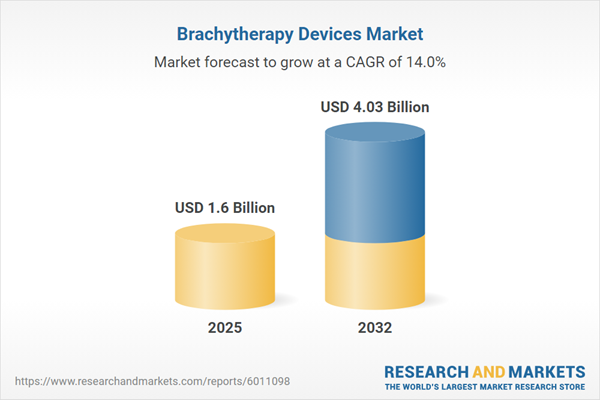Speak directly to the analyst to clarify any post sales queries you may have.
The Brachytherapy Devices Market is evolving rapidly as clinical needs shift toward precise, minimally invasive oncology care. Strategic innovations in device safety, imaging integration, and workflow optimization are transforming how providers deliver targeted radiotherapy.
Market Snapshot: Brachytherapy Devices Market
The Brachytherapy Devices Market grew from USD 1.41 billion in 2024 to USD 1.60 billion in 2025. It is expected to continue growing at a CAGR of 13.99%, reaching USD 4.03 billion by 2032.
Scope & Segmentation
- Product Types: High Dose Rate, Low Dose Rate, Pulsed Dose Rate
- Applications: Breast Cancer, Cervical Cancer, Ocular Tumors, Prostate Cancer
- Source Types: Cs-137, I-125, Ir-192, Pd-103
- End Users: Ambulatory Surgical Centres, Cancer Research Centers, Hospitals
- Regions Covered: Americas (United States, Canada, Mexico, Brazil, Argentina, Chile, Colombia, Peru), Europe, Middle East & Africa (United Kingdom, Germany, France, Russia, Italy, Spain, Netherlands, Sweden, Poland, Switzerland, United Arab Emirates, Saudi Arabia, Qatar, Turkey, Israel, South Africa, Nigeria, Egypt, Kenya), Asia-Pacific (China, India, Japan, Australia, South Korea, Indonesia, Thailand, Malaysia, Singapore, Taiwan)
- Technologies: Digital treatment planning, 3D imaging integration, remote afterloading systems, robotic-assisted applicators, source encapsulation materials, software platforms for treatment analytics
- Companies Profiled: Varian Medical Systems, Elekta, Ion Beam Applications, C. R. Bard, Eckert & Ziegler, Theragenics, IsoRay, Proxima Therapeutics, Shanghai Atom High-Tech, Best Medical International
Key Takeaways
- Advancements in imaging modalities and digital treatment planning have improved precision, allowing clinicians to address tumors with higher accuracy and less damage to healthy tissue.
- Robotic systems and miniaturized applicators now enable safe treatment of complex anatomical regions, expanding eligible patient populations.
- Quality assurance and integration with electronic health records are streamlining data collection, benchmarking, and operational management across clinical sites.
- Healthcare providers are prioritizing devices with outcome-driven features, while manufacturers focus on innovation aligned with surgical workflows and clinical trial validation.
- The shift toward minimally invasive, same-day procedures supports broader healthcare trends in patient comfort and resource optimization.
- Strategic partnerships and research collaborations are central to overcoming regulatory challenges and sustaining long-term growth.
Brachytherapy Devices Market: Tariff Impact
Recent tariffs in the United States targeting core components and isotope sources have prompted manufacturers and healthcare systems to reconsider their sourcing and supply chain strategies. Companies are exploring onshore production, multi-sourcing, and technology transfers to mitigate cost pressures. Stakeholders are reinforcing risk management, adjusting procurement timelines, and strengthening relationships with suppliers to maintain continuity in device supply and patient care.
Methodology & Data Sources
This report is driven by primary research with oncologists, medical physicists, executives, and regulatory experts. Secondary research includes peer-reviewed literature, patent analysis, and public disclosures. Quantitative data from registries and supply chains is triangulated with stakeholder input. An expert advisory panel validates models and assumptions for reliability and robustness.
Why This Report Matters
- Enables confident decision making on investment and partnership opportunities in precision oncology technologies.
- Equips industry leaders with actionable segmentation and regional insights to inform growth strategies and operational planning.
- Provides thorough coverage of evolving regulatory, technological, and supply chain challenges, supporting competitive differentiation.
Conclusion
This analysis prepares stakeholders to navigate a shifting market, leverage technological and clinical advancements, and align with emerging care models in brachytherapy. Informed action now will position organizations for resilience and sustainable growth as oncology care continues to modernize.
Additional Product Information:
- Purchase of this report includes 1 year online access with quarterly updates.
- This report can be updated on request. Please contact our Customer Experience team using the Ask a Question widget on our website.
Table of Contents
3. Executive Summary
4. Market Overview
7. Cumulative Impact of Artificial Intelligence 2025
Companies Mentioned
The companies profiled in this Brachytherapy Devices market report include:- Varian Medical Systems, Inc.
- Elekta AB (publ)
- Ion Beam Applications S.A.
- C. R. Bard, Inc.
- Eckert & Ziegler AG
- Theragenics Corporation
- IsoRay, Inc.
- Proxima Therapeutics, Inc.
- Shanghai Atom High-Tech Co., Ltd.
- Best Medical International, Inc.
Table Information
| Report Attribute | Details |
|---|---|
| No. of Pages | 180 |
| Published | October 2025 |
| Forecast Period | 2025 - 2032 |
| Estimated Market Value ( USD | $ 1.6 Billion |
| Forecasted Market Value ( USD | $ 4.03 Billion |
| Compound Annual Growth Rate | 13.9% |
| Regions Covered | Global |
| No. of Companies Mentioned | 11 |









